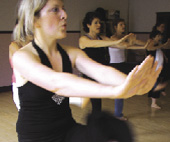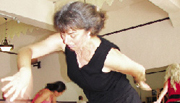home | metro santa cruz index | features | santa cruz | feature story
Health and Fitness Issue:
Insomnia | Vitamin Center | NIA

Getting down with NIA: Dancers explore their mobility potential through improvisation.
Movement of the People
Neuromuscular Integrative Action and other movement-based therapies teach participants to listen to their bodies
By Laura Mattingly
She tells us to shout "yes."And we do. And it's liberating. We're reclaiming our bodies. I, and a dozen other dancers, stand in front of a mirror, arms outstretched, in the upstairs of the Santa Cruz Vets Hall.
We're standing on a hardwood floor.
She says, "Step into the NIA space. ... Let your feet settle down into the earth. Visualize yourself walking in mud; feel it squish between your toes."
As a person with 10 years of classical ballet training, I associate dance with point shoes, injuries, poor eating habits and bloody toes. You can't look beautiful without a fight.
But Neuromuscular Integrative Action (NIA) is a fairly new dance form, created in 1983 by Debbie and Carlos Rosas, and is unlike any other I'd ever practiced. Rather than being performance driven--every move calculated to please an observer--this dance is practiced entirely for the purpose of seeking and maintaining personal health.
In the NIA class taught by Cynthia Myers in Santa Cruz, we are not told to force our legs and arms into a prescribed form or technique, and to ignore pain.
Myers encourages us to listen to our bodies.
"Find your joy," Myers says.
NIA, according to Myers, is informed by a "triad" of traditions: dance, martial and healing arts. And within each art, NIA draws from different movement forms.
"So in the dance art, we draw from predominately jazz dance, Duncan dance and modern dance. From within the martial arts we draw from aikido, the art of blending, tai chi and tai kwon do."
NIA's creators, Debbie and Carlos Rosas, had long histories in fitness and movement, Carlos having been a professional tennis player, Debbie having owned multiple fitness centers, and both having backgrounds in martial arts.
"We wanted to create a fitness experience for people that would integrate all parts of themselves, their body, their mind, their emotions and their spirit," Debbie Rosas says, "so that people would walk away having had a very meaningful experience, that was personal to them, and something that would help people to open up to new parts of themselves that they may not have connected to, such as their emotional being, or their imagination, and create something that would really make room for people who had, for instance fibromyalgia, or people who were overweight, to really make something that would be available to the general population."
Rosas herself had suffered from numerous physical ailments, and in her search for ways to improve her own health, she found she could help others to improve their health as well.
"I actually came from being a child who was sick. I had learning disabilities, I had a speech impediment. ... Being in a body was not a very happy place," she says.
"The work of using movement to get into my body became a very healing process for me. And consequently so much of the NIA work is helping people to heal and get into their bodies," says Rosas. "So while the program started out as an exercise program, it really has developed into something much more."
The NIA dance program now extends to 31 countries throughout the world, functioning with 1,500 certified instructors. Not only offered in fitness centers, NIA finds a home in hospitals and universities, including Toronto University and Harvard.
NIA is not just another aerobics class.
At the beginning of every class she teaches, Myers introduces a specific "focus" of the day, and sometimes she reads a poem.
"Welcome to the NIA experience. Today we will be working with the first principle of NIA, which is the joy of movement."
In addition to the gift of dance, Myers also has the gift of gab, and she narrates the class using visualization techniques, sometimes associated with guided meditations, "soar like eagles ... now imagine yourself in a bubble ... we're also warriors, 'Hut!'"
Myer's narration also helps to direct the dancers' focus to different parts of the body. She'll remind you to breathe and to maintain balance, and she'll suggest that you let your feet explore.
Her approach is a synthesis of Eastern philosophy and Western dance, and she'll talk about the "universal chi" to the sound of African drumbeats or the London Philharmonic.
"With each routine we draw from those different concepts [dance, martial and healing arts] and put it together in a very dynamic way. And ideally we want to fuse together those different things," says Myers.
"My interest in spirituality and my interest in healing has been the main focus of my life for 13 years," explains Myers, who says she's traveled extensively and receives healings and instruction from many types of healers and teachers. She's practiced the dances of universal peace and Sufism, and attended an Ancient Esoteric Wisdom school. In addition to teaching NIA she's also a massage and Reiki practitioner.
Working in the field of health, and staying true to NIA tradition, Myers makes a conscious effort to make the class accessible to dancers of any level of experience and any level of mobility.
Wioleta Kaminska came to her first NIA class two years ago with no prior background in dance, following an injury from playing squash.
"This class helped me to heal not just physically but emotionally and creatively," says Kaminska. "I gave up the gym."
Carol Shwery, a local chiropractor, experimented with NIA following brain tumor surgery two years ago.
"I was paralyzed on one side and I was looking for something I could do that wouldn't make me feel bad if I couldn't do something well. And it has helped me tremendously in the meantime," says Shwery. "I still can't do some things with my right leg, but I just do what I can do, you know?"

Don't forget to breathe: Wioleta Kaminska (foreground) executes an NIA routine combining a martial arts kick with specific breathing and vocalization.
The healing arts component of NIA is inspired by the Feldenkrais method, the Alexander technique and yoga.
Lawrence William Goldfarb, has been practicing the Feldenkrais method for 23 years, and has had a practice in Santa Cruz for 15.
He's not your typical doctor. Goldfarb has a Ph.D. in movement science.
He also has a lifelong background in dance. As well as working with people suffering from neurological damage, he also teaches the Feldenkrais method to professional dancers, so he definitely recognizes the connection between movement and health, and between health and dance.
"There are different kinds of exercise," says Goldfarb. "When people think of exercise, they usually think of strength and endurance training. Then there's another category, which you could call coordination training, or sensory motor education, or people call it different things. That's really what I do. I deal with the way people coordinate their movement."
Though Feldenkrais is not a medical procedure, Goldfarb does often make people feel better. He does so by studying the way patients move and identifying how they can move in a better way for their body. He also works to teach his patients how to listen to their own bodies, so they can maintain healthy movement themselves.
"If someone comes to me with back pain, I'm not going to change their disk, but I'm gonna help them find a way to move that's more comfortable and less dangerous. So most of the time, even if there's some kind of organic problem, I can help them change how they respond to it," says Goldfarb. "And that can make a huge difference."
He assists people with problems as varied as mild arthritis and paralysis.
"The idea of Feldenkrais really is that the nervous system is plastic. The brain changes as we learn," says Goldfarb. "And all of the research being done in movement science these days really supports what Feldenkrais said, 50, 60 years ago. So, I would say science is catching up with us."
So according to Goldfarb, changing the way you move can actually change the connections in the brain, significantly altering a person's experience of life.
"I work with kids who have neurological problems. So, like, there are two kids I was working with for the last couple years who were born three months premature; they're twins. And they couldn't move. They couldn't sit up, they couldn't roll over, they couldn't crawl. And the doctor had told the parents, 'Forget it, they're going to be retarded,'" says Goldfarb.
"And they learned to crawl and they learned to walk, and now they're jumping and running and talking," says Goldfarb. "So I kind of work with people that other people have given up on."
NIA's approach, like the Feldenkrais method, puts emphasis on the needs of the individual, and the unique state of each person's health and mobility, rather than on technical conformity. It's about making a home in your body.
"Feldenkrais is different than dance because most dance is taught from the outside in, you could say, so it's about observing how someone else moves, and copying it. And Feldenkrais is really taught from the inside out," says Goldfarb. "There's no teaching through imitation. There's really just learning to listen to yourself, learning what to notice on the inside and how to better understand what's going on with yourself."
Myers echoes Goldfarb's sentiments, but in more personal terms. "My deepest truth is that my soul knows myself as a dancer," she says. "NIA for me was like tapping into this deep remembrance in my soul that said yes this is you, and this is the way you express, and you've expressed this way many times before, and now you will remember how to express this way again. NIA moves me on a very deep level."
Cynthia Myers teaches NIA classes at 11am on Tuesday, Thursday, and Saturday at the Vets Hall in Santa Cruz.
Send a letter to the editor about this story.
|
|
|
|
|
|